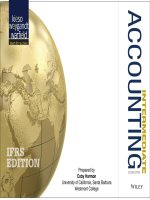Lecture Accounting principles (8th edition) – Chapter 14: Corporations: Dividends, retained earnings, and income reporting
Bạn đang xem bản rút gọn của tài liệu. Xem và tải ngay bản đầy đủ của tài liệu tại đây (650.93 KB, 37 trang )
Chapter
14-1
CHAPTER
CHAPTER 14
14
CORPORATIONS:
DIVIDENDS, RETAINED
EARNINGS, AND INCOME
REPORTING
Accounting Principles, Eighth Edition
Chapter
14-2
Study Objectives
Study Objectives
1.
Prepare the entries for cash dividends and stock dividends.
2.
Identify the items reported in a retained earnings statement.
3.
Prepare and analyze a comprehensive stockholders’ equity section.
4.
Describe the form and content of corporation income statements.
5.
Compute earnings per share.
Chapter
14-3
Corporations: Dividends, Retained Earnings, and
Corporations: Dividends, Retained Earnings, and
Income Reporting
Income Reporting
Dividends
Dividends
Cash dividends
Stock dividends
Stock splits
Chapter
14-4
Retained
Retained
Earnings
Earnings
Retained earnings
restrictions
Prior period
adjustments
Retained earnings
statement
Statement
Statement
Presentation
Presentationand
and
Analysis
Analysis
Stockholders’
Equity
Presentation
Stockholders’
Equity Analysis
Income Statement
Presentation
Income Statement
Analysis
Dividends
Dividends
A distribution of cash or stock to stockholders on a pro rata
(proportional) basis.
Types of Dividends:
1.
Cash dividends.
3.
Script (promissory note).
2.
Property dividends.
4.
Stock dividends.
Dividends expressed: (1) as a percentage of the par or stated value, or (2) as
a dollar amount per share.
Chapter
14-5
LO 1 Prepare the entries for cash dividends and stock dividends.
Dividends
Dividends
Dividends require information concerning three dates:
Chapter
14-6
LO 1 Prepare the entries for cash dividends and stock dividends.
Dividends
Dividends
Cash Dividends
For a corporation to pay a cash dividend, it must have:
1. Retained earnings Payment of cash dividends from retained
earnings is legal in all states.
2. Adequate cash.
3. A declaration of dividends by the Board of Directors.
Chapter
14-7
LO 1 Prepare the entries for cash dividends and stock dividends.
Dividends
Dividends
Illustration: What would be the journal entries made by a
corporation that declared a $50,000 cash dividend on March 10,
payable on April 6 to shareholders of record on March 25?
March 10 (Declaration Date)
Retained earnings
Dividends payable
50,000
March 25 (Date of Record)
50,000
No entry
April 6 (Payment Date)
Dividends payable
Cash
Chapter
14-8
50,000
50,000
LO 1 Prepare the entries for cash dividends and stock dividends.
Dividends
Dividends
Allocating Cash Dividends Between Preferred and
Common Stock
Holders of cumulative preferred stock must be paid any unpaid
prioryear dividends before common stockholders receive
dividends.
Chapter
14-9
LO 1 Prepare the entries for cash dividends and stock dividends.
Dividends
Dividends
Exercise Arnez Corporation was organized on January 1, 2008. During
Exercise
its first year, the corporation issued 2,000 shares of $50 par value preferred
stock and 100,000 shares of $10 par value common stock. At December 31,
the company declared the following cash dividends: 2008, $6,000, 2009,
$12,000, and 2010, $28,000.
Instructions: (a) Show the allocation of dividends to each class of stock,
assuming the preferred stock dividend is 8% and not cumulative.
Chapter
14-10
LO 1 Prepare the entries for cash dividends and stock dividends.
Dividends
Dividends
Exercise (a) Show the allocation of dividends to each class of stock,
Exercise
assuming the preferred stock dividend is 8% and not cumulative.
Divid e nd s d e c la r e d
Allo c a tio n to pr e f e r r e d
Re ma ind e r to c o mmo n
2008
2009
2 0 10
$ 6 ,0 0 0
$ 12 ,0 0 0
$ 2 8 ,0 0 0
* 6 ,0 0 0
8 ,0 0 0
8 ,0 0 0
$ 4 ,0 0 0
$ 2 0 ,0 0 0
$
* 2,000 shares x $50 par x 8% = $8,000
Chapter
14-11
LO 1 Prepare the entries for cash dividends and stock dividends.
Dividends
Dividends
Exercise (b) Show the allocation of dividends to each class of stock,
Exercise
assuming the preferred stock dividend is 9% and cumulative.
Divid e nd s d e c la r e d
2008
2009
2 0 10
$ 6 ,0 0 0
$ 12 ,0 0 0
$ 2 8 ,0 0 0
Divid e nd s in a r r e a r s
Allo c a tio n to pr e f e r r e d
Re ma ind e r to c o mmo n
3 ,0 0 0
*
6 ,0 0 0
9 ,0 0 0
$
$
**
9 ,0 0 0
$ 19 ,0 0 0
* 2,000 shares x $50 par x 9% = $9,000
** 2008 Pfd. dividends $9,000 – declared $6,000 = $3,000
Chapter
14-12
LO 1 Prepare the entries for cash dividends and stock dividends.
Dividends
Dividends
Exercise (c) Journalize the declaration of the cash dividend at December
Exercise
31, 2010, under part (b).
Divid e nd s d e c la r e d
2008
2009
2 0 10
$ 6 ,0 0 0
$ 12 ,0 0 0
$ 2 8 ,0 0 0
Divid e nd s in a r r e a r s
Allo c a tio n to pr e f e r r e d
6 ,0 0 0
9 ,0 0 0
9 ,0 0 0
Re ma ind e r to c o mmo n
$
$
$ 19 ,0 0 0
Journal entry:
Retained earnings
Dividends payable
Chapter
14-13
3 ,0 0 0
28,000
28,000
LO 1 Prepare the entries for cash dividends and stock dividends.
Dividends
Dividends
Stock Dividends
Illustration 143
Pro rata distribution of the corporation’s own stock.
Results in decrease in retained earnings and increase in paidin capital.
Chapter
14-14
LO 1 Prepare the entries for cash dividends and stock dividends.
Dividends
Dividends
Stock Dividends
Reasons why corporations issue stock dividends:
1. To satisfy stockholders’ dividend expectations without spending cash.
2. To increase the marketability of the corporation’s stock.
3. To emphasize that a portion of stockholders’ equity has been
permanently reinvested in the business.
Chapter
14-15
LO 1 Prepare the entries for cash dividends and stock dividends.
Dividends
Dividends
Size of Stock Dividends
Small stock dividend (less than 20–25% of the corporation’s
issued stock, recorded at fair market value)
*
Large stock dividend (greater than 20–25% of issued stock,
recorded at par value)
* This accounting is based on the assumption that a small stock dividend will
have little effect on the market price of the outstanding shares.
Chapter
14-16
LO 1 Prepare the entries for cash dividends and stock dividends.
Dividends
Dividends
Illustration: HH Inc. has 5,000 shares issued and outstanding. The per
share par value is $1, book value $32 and market value is $40.
10% stock dividend is declared
Retained earnings
(5,000 x 10% x $40)
Common stock dividends distributable
Additional paidin capital
20,000
500
19,500
Stock issued
Common stock div. distributable
Common stock (5,000 x 10% x $1)
Chapter
14-17
500
500
LO 1 Prepare the entries for cash dividends and stock dividends.
Dividends
Dividends
Stockholders’ Equity with Dividends Distributable
HH Inc.
Balance Sheet (partial)
Stockholders' equity
Paid-in capital
Common stock, $1 par, 5,000 issued
and outstanding
Common stock dividends distributable
Paid-in capital in excess of par
Retained earnings
Total stockholders' equity
Chapter
14-18
$
5,000
500
64,500
90,000
$ 160,000
LO 1 Prepare the entries for cash dividends and stock dividends.
Dividends
Dividends
Effects of Stock Dividends
HH Inc.
Before
Dividend
Stockholders' equity
Paid-in capital
Common stock, $1 par, 5,000 issued
and outstanding
Paid-in capital in excess of par
Retained earnings
Total stockholders' equity
Outstanding shares
Book value per share
Chapter
14-19
$
5,000
45,000
110,000
$ 160,000
$
5,000
32
After
Dividend
$
5,500
64,500
90,000
$ 160,000
$
Net
Change
$ 500
19,500
(20,000)
$ 0
5,500
29
LO 1 Prepare the entries for cash dividends and stock dividends.
Dividends
Dividends
Question
Which of the following statements about small stock dividends is true?
a. A debit to Retained Earnings for the par value of the shares issued
should be made.
b. A small stock dividend decreases total stockholders’ equity.
c.
Market value per share should be assigned to the dividend shares.
d. A small stock dividend ordinarily will have no effect on book value
per share of stock.
Chapter
14-20
LO 1 Prepare the entries for cash dividends and stock dividends.
Dividends
Dividends
Question
In the stockholders’ equity section, Common Stock Dividends
Distributable is reported as a(n):
a. deduction from total paidin capital and retained earnings.
b. current liability.
c. deduction from retained earnings.
d. addition to capital stock.
Chapter
14-21
LO 1 Prepare the entries for cash dividends and stock dividends.
Dividends
Dividends
Stock Split
Reduces the market value of shares.
No entry recorded for a stock split.
Decrease par value and increase number of shares.
Chapter
14-22
LO 1 Prepare the entries for cash dividends and stock dividends.
Dividends
Dividends
Illustration: HH Inc. has 5,000 shares issued and outstanding. The
per share par value is $1, book value $32 and market value is $40.
2 for 1 Stock Split
No Entry Disclosure that par is now $.50 and shares
outstanding are 10,000.
Chapter
14-23
LO 1 Prepare the entries for cash dividends and stock dividends.
Dividends
Dividends
Effects of Stock Dividends
HH Inc.
Before
Split
Stockholders' equity
Paid-in capital
Common stock
Paid-in capital in excess of par
Retained earnings
Total stockholders' equity
Outstanding shares
Book value per share
Chapter
14-24
$
5,000
45,000
110,000
$ 160,000
$
5,000
32
After
Split
$
5,000
45,000
110,000
$ 160,000
Net
Change
$
$
-
10,000
$
16
LO 1 Prepare the entries for cash dividends and stock dividends.
Retained Earnings
Retained Earnings
Retained earnings is net income that a company retains for use
in the business.
Net income increases Retained Earnings and a net loss decreases
Retained Earnings.
Retained earnings is part of the stockholders’ claim on the total
assets of the corporation.
A debit balance in Retained Earnings is identified as a deficit.
Chapter
14-25
LO 2 Identify the items reported in a retained earnings statement.









